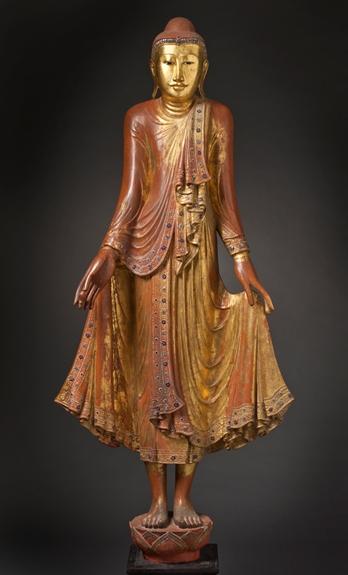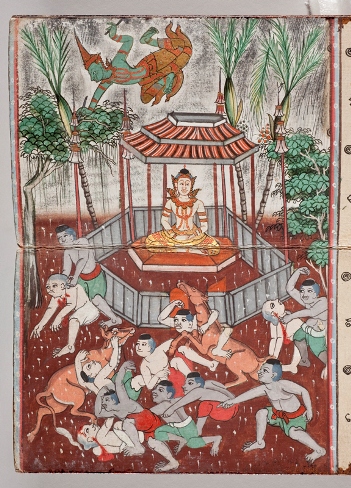Tucked away in the corner gallery of the Ahmanson Building’s fourth floor is a recently opened installation of twelve works from our Southeast Asian collection, The Way of the Elders: The Buddha in Modern Theravada Traditions. Theravada (which translates to “Way of the Elders”) is the school of Buddhism still practiced in Sri Lanka and much of Southeast Asia. Art is often commissioned and donated to Buddhist temples and monasteries to bring merit to the donor and their love ones on special occasions such as annual festivals and ordination ceremonies. Here are just a few highlights from the installation, which features a range of media from Burma, Cambodia, Thailand, and Sri Lanka, all made between the eighteenth century and the present. Many of these objects in this installation are on view for the first time.
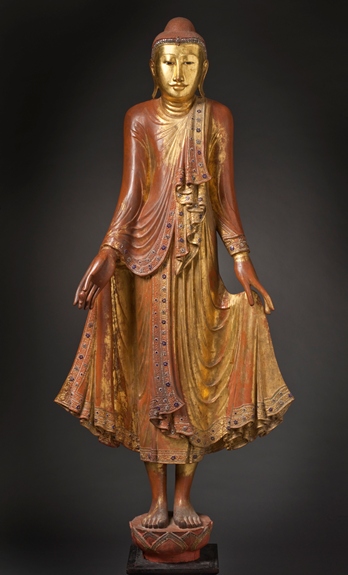
Buddha Shakyamuni, Burma (Myanmar), Mandalay, 20th century, gift of Gerald Stockton and S. Louis Gaines
With its oval face, elongated arms and fingers, and carefully chiseled drapery, this wood-carved and gilded Buddha image from Burma is characteristic of a style that developed in Mandalay in the late eighteenth and early nineteenth centuries. Gilding of Buddha images, also considered a meritorious act, is applied using lacquer made from tree sap, which is sometimes mixed with a red pigment made from cinnabar. Lacquer is also used to sculpt the curls of the Buddha’s hair and his ushnisha (a cranial protuberance signifying his status as an enlightened being), and as a mortar for the intricately designed inlaid glass decorating his headband and the borders of his robes.
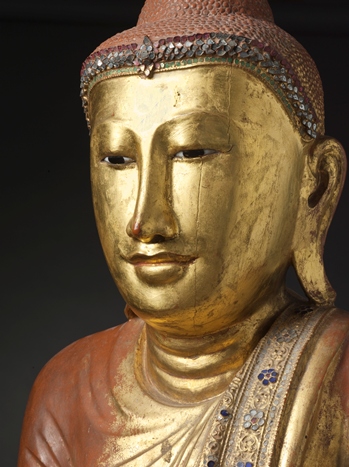
Detail
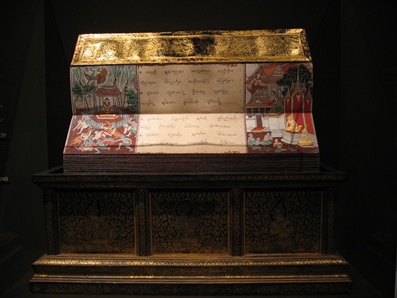
LSRFY11 install photo 009- Left: The Chandrakumara Jataka, on Forbearance; Right: The Narada Jataka, on Equanimity, pages from a manuscript illustrated with the Ten Previous Lives of the Buddha, Thailand, c. 1860–80, gift of Mr. and Mrs. Frank Neustatter; Below: Sutra Box, Thailand, c. 1920–40, Indian Art Special Purpose Fund
Ritual manuscripts such as this one from Thailand are often illustrated with scenes from Buddhist jatakas—stories which recount the historical Buddha Shakyamuni’s numerous rebirths. The last ten jatakas are considered the most important as they symbolize the perfection of the ten virtues (renunciation, perseverance, devotion, resolution, wisdom, perseverance, forbearance, equanimity, truthfulness, and generosity). This manuscript has been opened to show two jataka paintings on either side of a page of ritual text. On the left one sees the final episode from the Chandrakumara Jataka on forbearance, in which the Buddha is born a prince who offers his life to save the inhabitants of the kingdom.
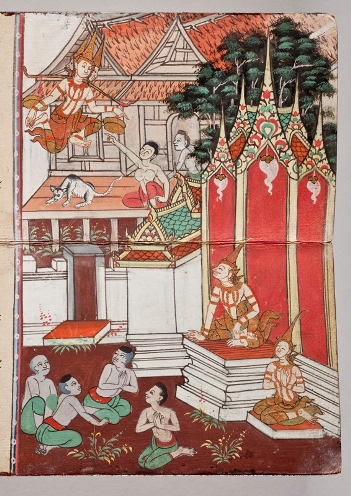
The Narada Jataka, on Equanimity
On the right is an episode from the Narada Jataka on equanimity in which the Buddha is born as the celestial deity Narada (the white figure in the upper left corner) who is summoned to earth to convince a disillusioned king of the importance of alms-giving.
Buddhist manuscripts are venerated as sacred texts (sutras), and are accordingly stored for safe keeping in gilded lacquer boxes such as the one on view here (in the installation photo above). This sutra box is decorated with protector deities and celestial worshippers of the Buddha, all of whom are kneeling with their hands held together in a gesture of prayer (anjali mudra). These figures are reminiscent of masked characters in traditional Thai dance-drama which are identified by their costume and facial features.
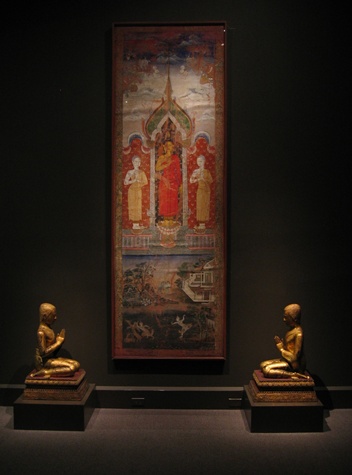
Above: Buddha Shakyamuni and his Principal Disciples, Maudgalyayana and Sariputra; Below: Scene from the Sama Jataka on Devotion, Thailand, late 19th century, gift of Margot and Hans Ries; Monk Devotees, Thailand, 19th century, gift from Doris Duke’s Southeast Asian Art Collection
This nineteenth century painting on cloth from Thailand contains both iconographic and narrative images related to the Buddha. The primary focus of this painting is the Buddha Shakyamuni, who is depicted here flanked by his two principle disciples, Maudgalayana and Sariputra. Below this triad is a jataka scene. The image in the lower register of the painting contains a scene from the Sama Jataka on devotion, in which the Buddha is born as the dutiful son of blind forest ascetics. Cloth banners were commissioned and donated to monasteries for hanging inside the temple walls until production ceased around the beginning of the twentieth century. The inscription at the bottom of this banner indicates it was given by a female devotee. We installed the banner in our gallery with a pair of gilt-bronze sculpted devotees, also from Thailand, to evoke the atmosphere of contemporary temple interiors that are decorated with myriad Buddha images as seen in this photo below from inside the ubosoth (chapel/prayer hall) of the Wat Thai in North Hollywood. The central figure is a large seated Buddha figure that is flanked by two standing devotees on either side facing inward with their hands in anjali mudra.
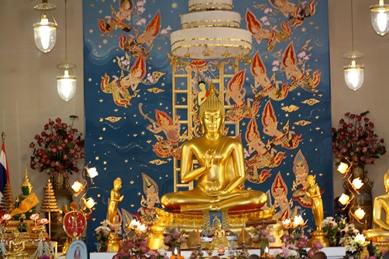
Image courtesy of Melody Rod-Ari
Julie Romain, Assistant Curator, South and Southeast Asian Art



